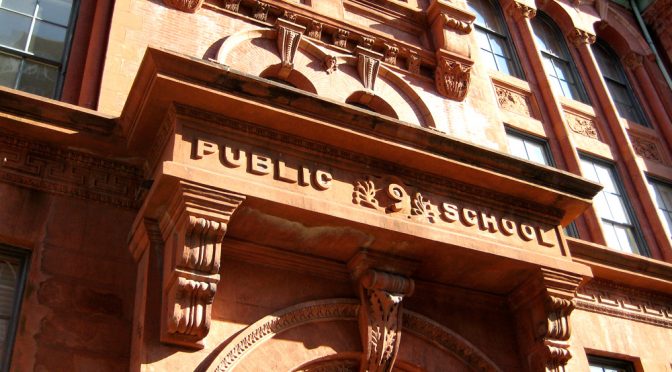This post was originally featured at the Gotham Center.
By Stephen Brier
The issue of who should control NYC’s public schools, like the poor, apparently will always be with us. These days, or at least since Michael Bloomberg’s mayoral reign, that control centers on how many years the city’s mayor will be allowed to play K-12 education’s top dog: one year or more? The answer to that question currently resides exclusively in the partisan clutches of Republicans who control the New York State Senate. They don’t like to miss an opportunity to stick it to the current occupant of Gracie Mansion, grudgingly doling out one year of mayoral control at a time to Bill de Blasio.
But control of the city’s public schools used to be a much larger and much more consequential issue than how many years the mayor gets to call the shots. Half a century ago this issue of control of the public schools roiled the city politically and racially, dividing thousands of parents of color from the overwhelmingly white (and largely Jewish) public school teachers and administrators. That conflict, which extended over several years from 1966 on, culminated in the UFT’s fall 1968 strike that put 57,000 teachers on picket lines for ten weeks and ended up throwing more than 1 million public school children out of their classrooms. That strike, which one historian has aptly described as the one that changed New York City, was waged over how much control the parents of NYC’s school children, nearly 40 percent of whom were then Black and Puerto Rican (the percentage of Blacks and Latinos is now 68) and the communities in which their children went to school would exercise over who would teach, what subjects would be taught, and how teaching and learning took place.
The UFT went out on strike in September 1968 to strangle in its infancy a few newly-formed and Board of Ed-sanctioned community control demonstration districts that had been set up in Harlem, Ocean Hill-Brownsville in Brooklyn, and the Lower East Side. The three demonstration projects gave community parents a real say in how their neighborhood schools would operate. Schools in those three communities continued to remain open during the UFT strike, staffed by a mix of black and white teachers, many of them young adults who believed passionately in the mission of community control of public education. The schools that continued to operate pioneered new subject matter (black history and African culture being the most pronounced) as well as new, progressive pedagogies, abandoning the forced discipline and rote recitation that defined much of public schooling in New York City in those years. This educational step forward was effectively undermined, however, by the successful UFT strike and the failed decentralization plan that the State of New York imposed on the city in 1970 in the strike’s wake. It was that failed 30-year long decentralization structure that led to the present era of mayoral control of the public schools that began with Bloomberg.
I was reminded about this historical debate about and the important political stakes involved in that nearly half century old struggle when I read the April 7, 2017 article in the New York Times entitled “Anger Over Principal Prompts Parents to Occupy East Harlem School Overnight.” The article indicates that parents at Central Park East 1 elementary school in East Harlem were upset by the actions of the school’s principal, Monika Garg, who they accused of “destroying the culture of the school.” That culture was one of openness and responsiveness to the needs of students and communities. The angry parents occupied the school’s auditorium overnight and vowed that they would stay until the principal resigned.
This parental action calls to mind another key moment in the battle for better schools in New York City: the People’s Board of Education, which emerged after a group of school parents refused to leave a NYC Board of Education meeting in Brooklyn early in December 1966 and took over the BOE meeting room to conduct their own hearings on what was wrong with the New York city public schools. That sit-in helped launch the control control movement that came to prominence a year later.
Central Park East (CPE) was founded in 1974 by legendary progressive educator Deborah Meier in the aftermath of the community control struggles of the 1960s and featured new pedagogical forms and active parental involvement in the operation of the school. The success of CPE over several decades encouraged the expansion of the original school, which was spun-off into several others, including CPE 1 and a CPE high school. The Times reporter aptly noted that the conflict at Central Park East 1 “has raised questions about who should control a school. . . .” Principal Garg seemed entirely unmoved by the parents’ actions and the parents chose to vacate the auditorium the next night after their one-day occupation. The final words in the article belong to Deborah Meier, now a senior scholar at NYU. Indicating that she considered the situation at CEP 1 “tragic and [that she] did not understand why Ms. Garg had not been replaced,” Meier concluded that “It’s beyond me that they would let children live in a school that is going through this for two years.” History repeating itself, first as tragedy…
Dr. Stephen Brier is a labor historian and part of the Consortial Faculty at The Murphy Institute.



